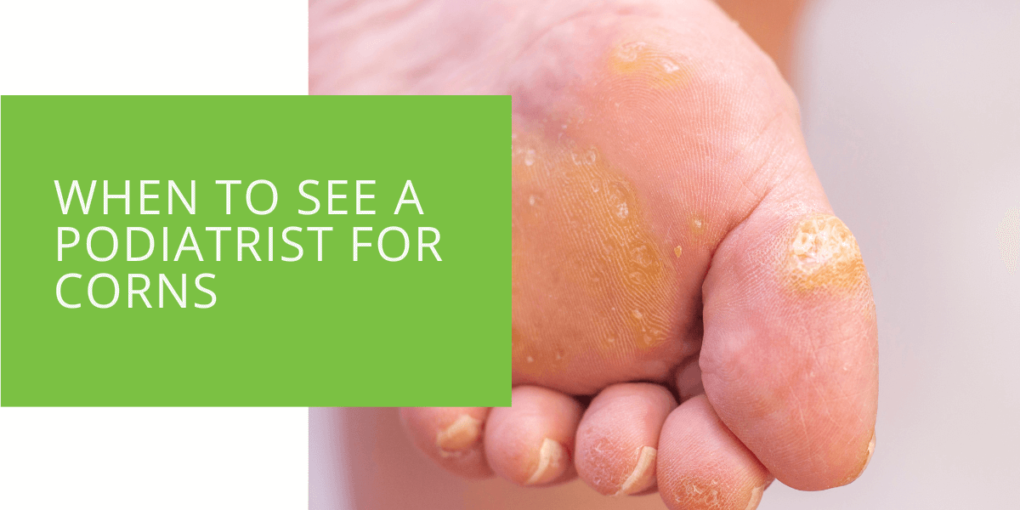When to See a Podiatrist for Corns
Corns and calluses are common foot conditions that affect many people. While often harmless, they can be painful and uncomfortable and may require medical intervention. This article will discuss when you should see a podiatrist for corn, treatment options, and prevention tips.
What are Corns and Calluses?
Corns and calluses are areas of thick, hardened skin that form in response to friction and pressure. They are similar in appearance but differ in location and thickness. Corns typically form on the tops and sides of the toes and are smaller and more concentrated than calluses. On the other hand, calluses are more widespread and often form on the soles of the feet.
When to Seek Medical Treatment for Corns and Calluses
Pain and Discomfort
If your corn or callus is causing significant pain or discomfort, it may be time to see a podiatrist. Corns and calluses can become inflamed and painful if left untreated and may even lead to infections or other complications.
Spreading or Increasing in Size
If your corn or callus is spreading or becoming larger, this could indicate a more serious underlying condition. For example, if you have a bony deformity like a bunion, this can cause pressure and friction that leads to the formation of corns and calluses. A podiatrist can assess your condition and provide appropriate treatment.
On Weight-Bearing Areas of the Foot
Corns and calluses that form on weight-bearing areas of the foot can be particularly painful and debilitating. These include the ball of the foot, the heel, and the toes. If you have a corn or callus in one of these areas, it may be time to seek medical treatment.
Medical Conditions
People with certain medical conditions may be at greater risk for developing complications from corns and calluses. These include people with diabetes, as neuropathy (nerve damage) can cause decreased foot sensation and increase the risk of infections. People with poor circulation or peripheral artery disease may also be at greater risk for complications.
Other Symptoms
If your corn or callus is accompanied by other symptoms, such as redness, swelling, or discharge, this could be a sign of infection. In this case, it's important to see a podiatrist as soon as possible to prevent the infection from spreading and causing further complications.

What to Expect During a Podiatrist Visit
Physical Examination
During your visit to the podiatrist, they will physically examine the affected area. This may involve inspecting the skin for signs of inflammation or infection and assessing the thickness and location of the corn or callus. The podiatrist may also assess your gait and foot structure to identify any underlying biomechanical issues contributing to the formation of corns and calluses.
Medical History Review
The podiatrist will also review your medical history to determine if any underlying conditions may contribute to the corn or callus formation. For example, if you have diabetes, this may increase your risk of complications from corns and calluses. The podiatrist may also ask about your daily activities, footwear, and hygiene practices to identify any factors contributing to the formation of the corn or callus.
Treatment Options
After assessing your condition, the podiatrist will recommend appropriate treatment options based on your corn or callus severity. This may include:
- Debridement: This involves removing the thickened skin of the corn or callus with a sharp blade or another instrument. The podiatrist may also use a chemical agent to soften the skin before debriding it.
- Padding: The podiatrist may apply padding to the affected area to alleviate pressure and pain. This may involve using a special adhesive padding or a moleskin patch to cushion the area.
- Orthotics: The podiatrist may recommend orthotics, such as custom shoe inserts, to correct any underlying biomechanical issues contributing to the formation of corns and calluses. This may involve taking a mold of your foot and using it to create a custom insert that fits your foot perfectly.
- Surgery (if necessary): In severe cases, surgery may be necessary to correct a bony deformity causing the corn or callus. This may involve removing a portion of the bone or repositioning it to alleviate pressure on the affected area.
Preventing Corns and Calluses
While not all cases of corns and calluses can be prevented, there are several things you can do to reduce your risk:
- Wear properly fitted shoes with adequate support.
- Avoid wearing high heels or shoes with pointed toes.
- Wear socks or stockings that fit well and do not bunch or wrinkle.
- Use a pumice stone or foot file to exfoliate dead skin gently.
- Soak your feet in warm water to soften the skin before using a pumice stone.
- Treat any foot conditions, such as bunions or neuropathy, that may contribute to the formation of corns and calluses.
Conclusion
While corns and calluses are common foot conditions, there are situations in which you should see a podiatrist for medical treatment. You can alleviate your pain and prevent further complications from corns and calluses by seeking prompt and effective treatment. And by taking preventive measures, you can reduce your risk of developing corns and calluses.

